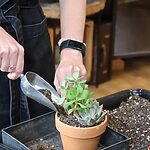Table of Content
- About
- Light
- Humidity
- Water
- Pests & Diseases
- Feed
- Pruning & Propagating
- Soil
- Repotting
- Troubleshooting & Tips
- Toxicity
- Species
- Senecio Peregrinus (String Of Dolphins)
- Senecio Rowleyanus (String Of Pearls)
- Senecio Radicans ( String of Bananas)
About
Senecio is a vast and varied genus of plant that belongs to the daisy family Asteraceae. The genus itself encompasses a massive range of flowering perennials which mainly thrive as outside plants in countries with warm and more temperate climates. Around 10% of the genus consists of succulents which we have grown to adore as houseplants.
While Senecio species can be found almost all over the world occupying all sorts of climates, the majority of species that we know as houseplants hail from tropical and arid regions of South Africa. It’s good to know where your variety of Sencio has come from as this will help you to adjust to give your plant the best environment. As a rule, care for most succulent Senecios is relatively consistent but some additional knowledge to keep them happy and healthy is required as they are not quite the same as other succulents.
Light
As most houseplant varieties of Senecio tend to be succulents they will require a high level of light. While they can tolerate full sun, prolonged exposure to direct sunlight indoors can cause scorch damage to the foliage.
These plants will be best suited to the brightest location possible and will appreciate a few hours of the morning or late afternoon sunlight. Senecio will adapt to tolerate more direct light but will have to be gradually exposed to these conditions so that no harm or shock is caused.
Humidity
The only time you need to worry about humidity is if the level is too high. As a succulent, Senecio is not too fussed about high humidity as it stores most of the water it needs in its leaves meaning it is not dependent on humidity to survive, making it well-adapted to tolerate average to low levels of moisture in the air.
Water
One of the most common issues with Sencio is overwatering, these plants are incredibly drought tolerant and don’t need a great deal to keep them happy. It is important to let the soil dry out completely before watering as this will help to prevent root rot and other issues the plant can develop with overwatering.
Sencio will need a touch more watering than your average succulent so it’s good practice to check them regularly but when in doubt it’s best to leave in drought.
Pests & Diseases
It is good practice to regularly check your plants for any signs of aphids, red spider mites, mealy bugs, and thrips. By checking regularly, you allow yourself time to prevent a full-blown attack.
The most common pests Senecio tends to suffer from are scale bugs and mealybugs. This will normally occur from a lack of airflow. If you can increase airflow the pests tend to subside but will need to be treated to fully get rid of the issue.

Check our video on homemade pest remedies or head over and read are Fungus Gnat Fact Check and Home Remedies how to guide
Feed
Senecio requires very little feeding and will often thrive better in low-nutrient soil. A good option would be to use specific cacti and succulent liquid feed only applied at the beginning of the growing season. During the winter months, Senecio shouldn’t be fed at all. The easiest and most effective way to give your plant a boost of nutrients is to simply top-dress them with a thin layer of compost.
Pruning & Propagating
There is not much pruning to be done with a Senecio, it is more a plant you leave to just get on with it. It is a good idea to prune any failing, diseased or dying growth. On occasion, if you have a more mature plant, you may need to give your Sencio a haircut and trim back its long dangling foliage. This is also a good idea if your plant has become a bit leggy and sparse.
Always use a clean and sterilised pair of scissors or secateurs to trim back!
The most effective way to propagate is by taking stem cuttings during periods of growth in the spring and summer. Simply cut the healthiest-looking growth you can find and allow this cutting to sit on a partially sunny window sill for a few weeks. Eventually, this cutting material will start producing new roots.
Place the cutting into a smallish pot with cactus potting mix.
Place the pot on a warm window sill where it will only get a few hours of direct morning light and continue to grow the plant.
Soil
When it comes to soil, Senecio is not too fussy. They can tolerate anything from slightly acidic to neutral soil. The most important thing these plants need is fast-draining soil. Without this, these plants won’t stand a chance and will quickly develop root rot.
The easiest option is to use a specific cactus potting mix which should provide adequate drainage and the right amounts of nutrients. Other good potting mixes you could use can be made up of; 3 parts potting soil, 2 parts coarse horticultural sand, and 1.5 parts of perlite.
Repotting
It’s best to repot your Senecio only when it’s root bound. Depending on the size of the plant, you may find yourself repotting every two to three years. They will happily stay root-bound and still maintain good health.
The pot size only wants to increase by a small margin as it’s easy for these plants to drown in pots that are slightly too big.
If you have reached your maximum pot size you will need to top-dress the plant once a year with a fresh layer of soil to replenish the nutrients.
The best time to repot your plant is when spring arrives and the plant is no longer dormant. Outside temperatures will rise and the daylight hours will increase. When this happens your Senecio will react quickly to the environmental change and start producing lots of new foliage growth.
You will need to pick a pot with excellent drainage, we don’t want water hanging around the roots.
Next, fill a third of the way up with your Cacti potting mix and place the root ball of the plant in the centre of the pot.
Fill the pot with the rest of your potting mix and firm down the soil.
When you’ve finished and got your plant back in the perfect spot you can give it a thorough watering to settle the plant into its new pot. Keep a close eye on it for the first couple of weeks and then relax back into your normal watering schedule. Avoid feeding for the rest of the season as this influx of additional nutrients can cause damage to the root system and make it difficult for the plant to settle into its new environment.
Troubleshooting & Tips
- If your plant is developing mushy stems and/or leaves this can be a late indicator of root rot and overwatering. If the plant has been severely overwatered it would be best to repot the plant in fresh soil, this will be the easiest way to get rid of excess water before the plant completely collapses.
- If your Senecio is putting on little to no growth or is producing leggy growth this is often a sign the plant isn’t receiving enough light and should be moved to a brighter location.
- Puckered leaves with dried brown edges or leaves with a bleached colour are often caused by overexposure to direct sunlight. These plants can tolerate direct light but will have to be gradually adapted to do so.
- Always make sure your Senecio is kept above 12ºC. Dropping below this temperature can cause shock and damage that can take months for the plant to recover from.
Toxicity
Most Senecios are somewhat toxic to humans and pets, while if ingested it wouldn’t be fatal it can cause some unpleasant side effects. It’s definitely best to keep out of munching distance of pets but is usually not an issue with these plants as most of the time they are kept as hanging plants so are naturally out of the way.
Species

Senecio Peregrinus (String Of Dolphins)
This gorgeous vining succulent is well known all over the world mainly for its unique foliage that is shaped like tiny dolphins hence the common name ‘Sting of Dolphins’. This plant is a hybrid and has been created by crossing two other species of Sencio. This, like many Sencios, is a must-have hanging plant with its long slender vivid green tendrils that can’t help but catch your attention.
Senecio Rowleyanus (String Of Pearls)
Another interesting and popular variety of Senecio makes for a curious trailing plant. The thick fleshy succulent leaves form into almost perfectly spherical beads that almost resemble a vivid green Christmas decoration. The long thread-like stems can stretch as far as a meter long and create a thick curtain of foliage.


Senecio Radicans ( String of Bananas)
This Senecio has been given the novel name String of Bananas due to the elongated thick fleshy leaves that are bright green with a slight blue shade. This trailing succulent produce long and slender dull green stems that produce a thick canopy of foliage that trail out of the pot like a waterfall.
If you enjoyed this guide head over to Articles & Blogs to learn more or check out our YouTube for even more useful information!














